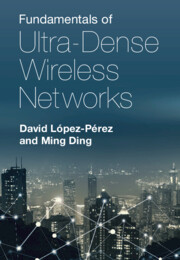Book contents
- Frontmatter
- Dedication
- Frontmatter
- Contents
- About the Authors
- Foreword
- Foreword
- Preface
- Acknowledgements
- List of Abbreviations
- Part I Getting Started
- Part II Fundamentals of Ultra-Dense Small Cell Networks
- Part III Capacity Scaling Law
- Part IV Dynamic Time Division Duplexing
- References
- Author Index
- References
References
Published online by Cambridge University Press: 17 June 2022
- Frontmatter
- Dedication
- Frontmatter
- Contents
- About the Authors
- Foreword
- Foreword
- Preface
- Acknowledgements
- List of Abbreviations
- Part I Getting Started
- Part II Fundamentals of Ultra-Dense Small Cell Networks
- Part III Capacity Scaling Law
- Part IV Dynamic Time Division Duplexing
- References
- Author Index
- References
- Type
- Chapter
- Information
- Fundamentals of Ultra-Dense Wireless Networks , pp. 381 - 395Publisher: Cambridge University PressPrint publication year: 2022



